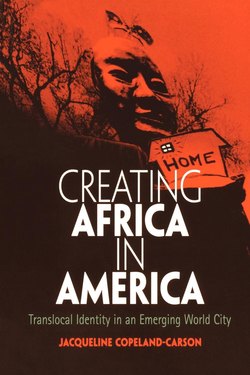Creating Africa in America

Описание книги
With a booming economy that afforded numerous opportunities for immigrants throughout the 1990s, the Twin Cities area has attracted people of African descent from throughout the United States and the world and is fast becoming a transnational metropolis. Minnesota's largest urban area, the region now also has the country's most diverse black population. A closely drawn ethnography, Creating Africa in America: Translocal Identity in an Emerging World City seeks to understand and evaluate the process of identity formation in the context of globalization in a way that is also site specific. Bringing to this study a rich and interesting professional history and expertise, Jacqueline Copeland-Carson focuses on a Minneapolis-based nonprofit, the Cultural Wellness Center, which combines different ethnic approaches to bodily health and community well-being as the basis for a shared, translocal «African» culture. The book explores how the body can become a surrogate locus for identity, thus displacing territory as the key referent for organizing and experiencing African diasporan diversity. Showing how alternatives are created to mainstream majority and Afrocentric approaches to identity, she addresses the way that bridges can be built in the African diaspora among different African immigrant, African American, and other groups. As this thoughtful and compassionate ethnographic study shows, the fact that there is no simple and concrete way to define how one can be African in contemporary America reflects the tangled nature of cultural processes and social relations at large. Copeland-Carson demonstrates the cultural creativity and social dexterity of people living in an urban setting, and suggests that anthropologists give more attention to the role of the nonprofit sector as a forum for creating community and identity throughout African diasporan history in the United States.
Отрывок из книги
Creating Africa in America
Kirin Narayan and Paul Stoller, Series Editors
.....
I attempt to apply and combine modified versions of what some scholars consider outmoded constructs—for example, “culture,” “thick ethnographic description,” and social network perspectives—with contemporary processual and reflexive approaches that look at the transnational flow of images and symbols, the construction of identity, and discourses on culture, race, gender, and hegemony, and with a self-consciousness of my sociopolitical role and impact as a native ethnographer.
As fieldwork progressed, it became evident that the intimate issues of health and wellness at the core of the CWC’s community-building agenda focus on the body as a vehicle and agent for cultural recall and revitalization. A more sensual approach to ethnography than is typical in ethnography of immigrant experiences and ethnicity was required. In constructing African identity, CWC was very much attempting to create a different way of conceptualizing, sensing, and reconnecting what they call the “mind/body/spirit divide.” The spoken word was critical for expressing and knowing the African reality the CWC was attempting to create. However, a methodology that privileges the written or spoken word over other ways of knowing would misconstrue a critical dimension of the CWC’s mission. Therefore, an explicit effort is made to accommodate multiple modes of expression—the sounds, smells, and rhythms that comprise the aesthetics of the CWC’s identity formation process.
.....
